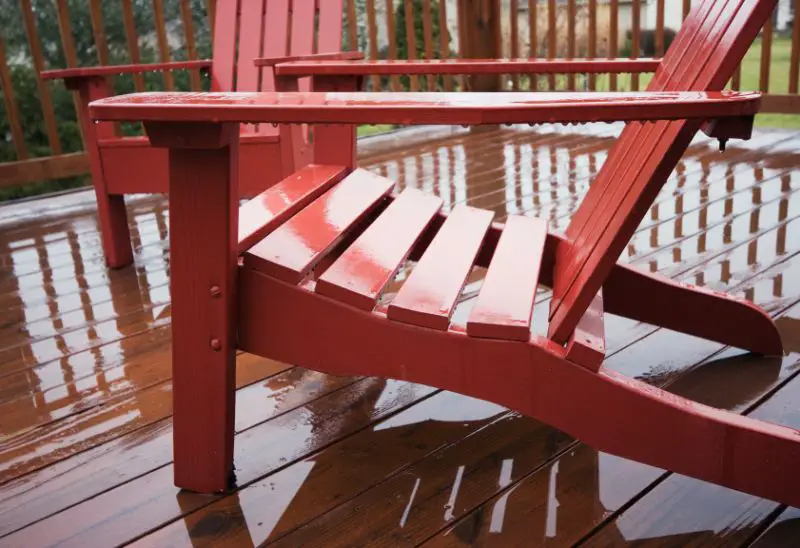Like a sailor navigating stormy seas, you might be wondering if your Adirondack chairs can withstand a deluge. Sure, they can get wet, but that’s not the whole story. There’s more to consider when it comes to preserving their longevity and beauty.
Just as we need shelter from the rain, these outdoor fixtures do too. The exposure to moisture can lead to wear and tear over time. But don’t worry, there are precautions you can take to ensure your Adirondack chairs survive the elements.
Understanding and managing the effects of wetness can help keep your chairs in shipshape condition.
Key Takeaways
- Different materials have different reactions to wet conditions, with plastic or synthetic chairs being water-resistant and wooden chairs being more susceptible to rot and warping.
- Fabric cushions and upholstery require regular drying to avoid mildew, but water-resistant options are available.
- Prevention methods for protecting Adirondack chairs from wetness include using waterproof covers, applying rain repellent sprays, using quick drying cushions, and attaching an umbrella for shelter.
- Recovery methods for wet Adirondack chairs include drying in direct sunlight or using fans and towels, cleaning with mild soap and water to prevent mold growth, and using bleach solution or appropriate leather care products if necessary.

The Wet Reality of Adirondack Chairs
You’re probably wondering how your Adirondack chair would fare in wet conditions, and it’s a concern that’s definitely worth discussing. Depending on the material, your chair may need different drying techniques or weatherproofing methods to survive various wetness levels.
Plastic or synthetic chairs, like Polywood or HDPE, are water warriors. They can endure rain, sprinkles, and spills without much fuss. However, you’ll need to be aware of quick drying methods to prevent any potential sun fading.
Wooden chairs, on the other hand, are more susceptible to rot and warping in continuous moisture. Regular application of moisture-resistant finishes and periodic sealing can help in protection. But, don’t forget to use waterproof covers during heavy snow or rain showers.
Fabric cushions and upholstery demand a different approach. They need regular drying to avoid mildew and regular cleaning with suitable cleaning solutions. You might want to consider water-resistant options for these.
Protecting Your Adirondack Throne: Prevention is Key
When it comes to safeguarding your Adirondack chair, prevention isn’t just beneficial, it’s essential. Waterproof covers are a simple yet effective way to shield your chair from prolonged wetness. Made from breathable materials, these covers prevent moisture trapping while their secure fastening ensures they’ll withstand wind and rain.
Rain repellent sprays can also be used to add an extra layer of protection. Regular reapplication is key, especially for wooden chairs, to maintain their protective shield against the elements. You might also want to consider eco-friendly and non-toxic options when choosing the right product for your material.
Quick drying cushions can be a lifesaver, allowing your seat to dry faster after a downpour. Strategic placement, such as under a tree or overhang, or in an area with good sun exposure, aids in faster drying too.
Umbrella attachments offer your chair shelter from both rain and sun, while waterproofing sealants provide a sturdy shield against moisture. Remember, off-season storage with covers can give your chair maximum longevity.
Dealing with the Drip: Recovery from Wetness
Despite your best efforts, if your Adirondack chair does get soaked, don’t panic – there are effective methods to recover from the dampness. Start with drying methods. Put your chair in direct sunlight for quick evaporation or use fans and towels for faster action. Pay special attention to cracks and crevices where water can hide.
Next, focus on mold prevention. Use mild soap and water for general cleaning. If mold is stubborn, cautiously apply a bleach solution. Deep cleaning is also effective, particularly for leather chairs which require a bit more leather care.
Lastly, assess the chair for any warping or rot, signs that water has caused serious issues. If it’s minor, DIY wood repair might suffice. Sand down the warped areas, apply wood filler if necessary, and refinish the surface. However, don’t hesitate to seek professional help for extensive damage.
Beyond the Wet: Additional Adirondack Chair Care Tips
Beyond dealing with moisture, there are a handful of additional care tips you’ll need to keep your Adirondack chair in top-notch condition. The following points will guide you through the best rainy day solutions, drying techniques, and moisture prevention methods.
When it comes to storing methods, always choose a dry, well-ventilated location. This ensures that any residual moisture evaporates, preventing mildew and mold growth.
Next, let’s consider waterproof covers. They’re a fantastic investment to shield your chair from rain, snow, and even sun. When the weather turns wet, simply cover your chair for ultimate protection.
Drying techniques are crucial too. After a downpour, make sure to wipe down your chair and let it dry completely in the sun. This will deter water damage and prolong the chair’s lifespan.
Lastly, be proactive with moisture prevention. Regular application of UV-resistant sealants and coatings can help repel water, reducing the risk of moisture-related damage.
- Invest in good storing methods
- Use waterproof covers
- Master drying techniques
- Be proactive with moisture prevention
Following these tips won’t only keep your Adirondack chair dry but also ensure it stays in excellent condition, regardless of the weather.
Frequently Asked Questions
What Materials Are Typically Used to Make Adirondack Chairs?”
Adirondack chairs are typically made of wood, plastic, or metal. Each material has its own advantages in terms of chair durability, weather resistance, sustainability factor, and maintenance tips. Choose what best suits your needs.
Can Adirondack Chairs Be Used Indoors as Well?”
Yes, you can use Adirondack chairs indoors. Consider indoor aesthetic, space, furniture pairing, chair functionality, and safety precautions. They’re not just for outdoors; they can add a rustic touch to your indoor spaces too.
How Often Should Adirondack Chairs Be Cleaned?”
You should clean your Adirondack chairs regularly, ideally once a month. Use eco-friendly cleaners and DIY techniques. A good maintenance schedule includes preventative measures to keep them looking their best for years to come.
Are There Specific Brands of Adirondack Chairs Known for Their Water-Resistant Properties?”
Yes, certain brands excel in water-resistance due to their waterproofing techniques and weatherproof materials. You’ll find brand comparisons helpful for durability assessment. Remember, maintenance tips can further enhance your chair’s resistance to water.
What Other Furniture Pieces Can Complement My Adirondack Chairs in an Outdoor Setting?”
Sure, you can enhance your outdoor setting with a selection of outdoor rugs, a fire pit, Adirondack themed lighting, and a patio umbrella. Don’t forget to incorporate side tables for additional functionality.





